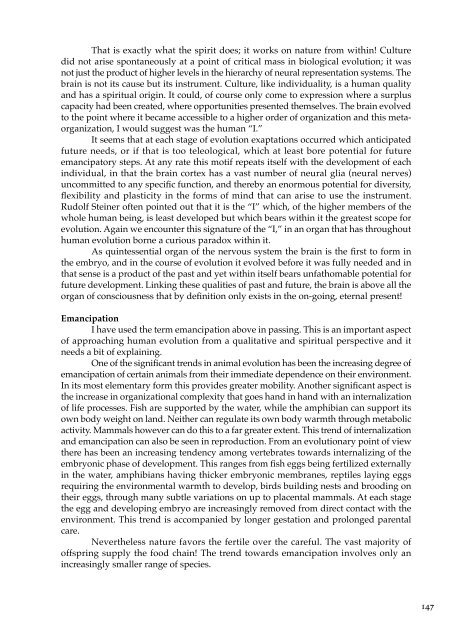The Spirit in Human Evolution - Waldorf Research Institute
The Spirit in Human Evolution - Waldorf Research Institute
The Spirit in Human Evolution - Waldorf Research Institute
Create successful ePaper yourself
Turn your PDF publications into a flip-book with our unique Google optimized e-Paper software.
That is exactly what the spirit does; it works on nature from with<strong>in</strong>! Culture<br />
did not arise spontaneously at a po<strong>in</strong>t of critical mass <strong>in</strong> biological evolution; it was<br />
not just the product of higher levels <strong>in</strong> the hierarchy of neural representation systems. <strong>The</strong><br />
bra<strong>in</strong> is not its cause but its <strong>in</strong>strument. Culture, like <strong>in</strong>dividuality, is a human quality<br />
and has a spiritual orig<strong>in</strong>. It could, of course only come to expression where a surplus<br />
capacity had been created, where opportunities presented themselves. <strong>The</strong> bra<strong>in</strong> evolved<br />
to the po<strong>in</strong>t where it became accessible to a higher order of organization and this metaorganization,<br />
I would suggest was the human “I.”<br />
It seems that at each stage of evolution exaptations occurred which anticipated<br />
future needs, or if that is too teleological, which at least bore potential for future<br />
emancipatory steps. At any rate this motif repeats itself with the development of each<br />
<strong>in</strong>dividual, <strong>in</strong> that the bra<strong>in</strong> cortex has a vast number of neural glia (neural nerves)<br />
uncommitted to any specific function, and thereby an enormous potential for diversity,<br />
flexibility and plasticity <strong>in</strong> the forms of m<strong>in</strong>d that can arise to use the <strong>in</strong>strument.<br />
Rudolf Ste<strong>in</strong>er often po<strong>in</strong>ted out that it is the “I” which, of the higher members of the<br />
whole human be<strong>in</strong>g, is least developed but which bears with<strong>in</strong> it the greatest scope for<br />
evolution. Aga<strong>in</strong> we encounter this signature of the “I,” <strong>in</strong> an organ that has throughout<br />
human evolution borne a curious paradox with<strong>in</strong> it.<br />
As qu<strong>in</strong>tessential organ of the nervous system the bra<strong>in</strong> is the first to form <strong>in</strong><br />
the embryo, and <strong>in</strong> the course of evolution it evolved before it was fully needed and <strong>in</strong><br />
that sense is a product of the past and yet with<strong>in</strong> itself bears unfathomable potential for<br />
future development. L<strong>in</strong>k<strong>in</strong>g these qualities of past and future, the bra<strong>in</strong> is above all the<br />
organ of consciousness that by def<strong>in</strong>ition only exists <strong>in</strong> the on-go<strong>in</strong>g, eternal present!<br />
Emancipation<br />
I have used the term emancipation above <strong>in</strong> pass<strong>in</strong>g. This is an important aspect<br />
of approach<strong>in</strong>g human evolution from a qualitative and spiritual perspective and it<br />
needs a bit of expla<strong>in</strong><strong>in</strong>g.<br />
One of the significant trends <strong>in</strong> animal evolution has been the <strong>in</strong>creas<strong>in</strong>g degree of<br />
emancipation of certa<strong>in</strong> animals from their immediate dependence on their environment.<br />
In its most elementary form this provides greater mobility. Another significant aspect is<br />
the <strong>in</strong>crease <strong>in</strong> organizational complexity that goes hand <strong>in</strong> hand with an <strong>in</strong>ternalization<br />
of life processes. Fish are supported by the water, while the amphibian can support its<br />
own body weight on land. Neither can regulate its own body warmth through metabolic<br />
activity. Mammals however can do this to a far greater extent. This trend of <strong>in</strong>ternalization<br />
and emancipation can also be seen <strong>in</strong> reproduction. From an evolutionary po<strong>in</strong>t of view<br />
there has been an <strong>in</strong>creas<strong>in</strong>g tendency among vertebrates towards <strong>in</strong>ternaliz<strong>in</strong>g of the<br />
embryonic phase of development. This ranges from fish eggs be<strong>in</strong>g fertilized externally<br />
<strong>in</strong> the water, amphibians hav<strong>in</strong>g thicker embryonic membranes, reptiles lay<strong>in</strong>g eggs<br />
requir<strong>in</strong>g the environmental warmth to develop, birds build<strong>in</strong>g nests and brood<strong>in</strong>g on<br />
their eggs, through many subtle variations on up to placental mammals. At each stage<br />
the egg and develop<strong>in</strong>g embryo are <strong>in</strong>creas<strong>in</strong>gly removed from direct contact with the<br />
environment. This trend is accompanied by longer gestation and prolonged parental<br />
care.<br />
Nevertheless nature favors the fertile over the careful. <strong>The</strong> vast majority of<br />
offspr<strong>in</strong>g supply the food cha<strong>in</strong>! <strong>The</strong> trend towards emancipation <strong>in</strong>volves only an<br />
<strong>in</strong>creas<strong>in</strong>gly smaller range of species.<br />
147
















